ARRIS 2W4100N 802.11b/g/n ADSL RESIDENTIAL GATEWAY User Manual
Pace Americas 802.11b/g/n ADSL RESIDENTIAL GATEWAY
ARRIS >
Installation Guide

HomePortal® Intelligent Gateway
Installation Guide
Supported Hardware Platform: 4111N/4112N
Notice to Users
© 2011 2Wire. All rights reserved. This manual in whole or in part, may not be reproduced, translated, or reduced to any machine-readable form without prior written approval.
2WIRE PROVIDES NO WARRANTY WITH REGARD TO THIS MANUAL, THE SOFTWARE, OR OTHER INFORMATION CONTAINED HEREIN, AND HEREBY EXPRESSLY DISCLAIMS ANY
IMPLIED WARRANTIES OF MERCHANTABILITY OR FITNESS FOR ANY PARTICULAR PURPOSE WITH REGARD TO THIS MANUAL, THE SOFTWARE, OR SUCH OTHER INFORMATION,
IN NO EVENT SHALL 2WIRE BE LIABLE FOR ANY INCIDENTAL, CONSEQUENTIAL, OR SPECIAL DAMAGES, WHETHER BASED ON TORT, CONTRACT, OR OTHERWISE, ARISING OUT
OF OR IN CONNECTION WITH THIS MANUAL, THE SOFTWARE, OR OTHER INFORMATION CONTAINED HEREIN OR THE USE THEREOF.
2Wire reserves the right to make any modification to this manual or the information contained herein at any time without notice. The software described herein is governed by the
terms of a separate user license agreement.
Updates and additions to software may require an additional charge. Subscriptions to online service providers may require a fee and credit card information. Financial services may
require prior arrangements with participating financial institutions.
2Wire, the 2Wire logo, and HomePortal are registered trademarks of 2Wire. All other trademarks are the property of their respective owners.
1112011
5100-001054-000
iii
Contents
About This Guide . . . . . . . . . . . . . . . . . . . . . . . . . . . . . . . . . . . . . . . . . . . . . iv
Audience. . . . . . . . . . . . . . . . . . . . . . . . . . . . . . . . . . . . . . . . . . . . . . . . . . . . . . . . . . . . . . . . .iv
Style Conventions . . . . . . . . . . . . . . . . . . . . . . . . . . . . . . . . . . . . . . . . . . . . . . . . . . . . . . . . .iv
Related Documents. . . . . . . . . . . . . . . . . . . . . . . . . . . . . . . . . . . . . . . . . . . . . . . . . . . . . . . . v
Support . . . . . . . . . . . . . . . . . . . . . . . . . . . . . . . . . . . . . . . . . . . . . . . . . . . . . . . . . . . . . . . . . . v
CHAPTER 1 Introducing the HomePortal Intelligent Gateway . . . . . . . . . . . . . . . . . . . 1
Components. . . . . . . . . . . . . . . . . . . . . . . . . . . . . . . . . . . . . . . . . . . . . . . . . . . . . . . . . . . . . . 1
CHAPTER 2 Installing the HomePortal Intelligent Gateway. . . . . . . . . . . . . . . . . . . . . . 3
Determining Gateway Location . . . . . . . . . . . . . . . . . . . . . . . . . . . . . . . . . . . . . . . . . . . . . 3
Connecting the Power Adapter . . . . . . . . . . . . . . . . . . . . . . . . . . . . . . . . . . . . . . . . . . . . . 3
Connecting Your Computer to the Gateway . . . . . . . . . . . . . . . . . . . . . . . . . . . . . . . . . . 4
Connecting through Local Ethernet . . . . . . . . . . . . . . . . . . . . . . . . . . . . . . . . . . . . . . 4
Connecting through Wireless . . . . . . . . . . . . . . . . . . . . . . . . . . . . . . . . . . . . . . . . . . . 4
Connecting the Broadband Interface through DSL port . . . . . . . . . . . . . . . . . . . . . . . . 6
Connecting the Broadband Interface through the Ethernet Port. . . . . . . . . . . . . . . . . 6
Connecting the IPTV Set-top Box . . . . . . . . . . . . . . . . . . . . . . . . . . . . . . . . . . . . . . . . . . . 7
CHAPTER 3 Troubleshooting Installation Issues . . . . . . . . . . . . . . . . . . . . . . . . . . . . . . .8
Connection Issues . . . . . . . . . . . . . . . . . . . . . . . . . . . . . . . . . . . . . . . . . . . . . . . . . . . . . . . . . 8
LAN Issues . . . . . . . . . . . . . . . . . . . . . . . . . . . . . . . . . . . . . . . . . . . . . . . . . . . . . . . . . . . . . . . 9
APPENDIX A Regulatory Information . . . . . . . . . . . . . . . . . . . . . . . . . . . . . . . . . . . . . . . . 10
Electrical . . . . . . . . . . . . . . . . . . . . . . . . . . . . . . . . . . . . . . . . . . . . . . . . . . . . . . . . . . . . . . . . 10
AC Adapter . . . . . . . . . . . . . . . . . . . . . . . . . . . . . . . . . . . . . . . . . . . . . . . . . . . . . . . . . . 10
Telecommunication Cord . . . . . . . . . . . . . . . . . . . . . . . . . . . . . . . . . . . . . . . . . . . . . . 10
Location – Electrical Considerations . . . . . . . . . . . . . . . . . . . . . . . . . . . . . . . . . . . . 10
Equipment. . . . . . . . . . . . . . . . . . . . . . . . . . . . . . . . . . . . . . . . . . . . . . . . . . . . . . . . . . . 10
Declaration of Conformity . . . . . . . . . . . . . . . . . . . . . . . . . . . . . . . . . . . . . . . . . . . . . . . . . . 11
FCC / Industry Canada Compliance . . . . . . . . . . . . . . . . . . . . . . . . . . . . . . . . . . . . . . 11
Part 15 of FCC Rules . . . . . . . . . . . . . . . . . . . . . . . . . . . . . . . . . . . . . . . . . . . . . . . . . . . 11
TIA 968 (Part 68 of FCC Rules) / IC CS-03. . . . . . . . . . . . . . . . . . . . . . . . . . . . . . . . 11
MPE/SAR/RF Exposure Information . . . . . . . . . . . . . . . . . . . . . . . . . . . . . . . . . . . . 12
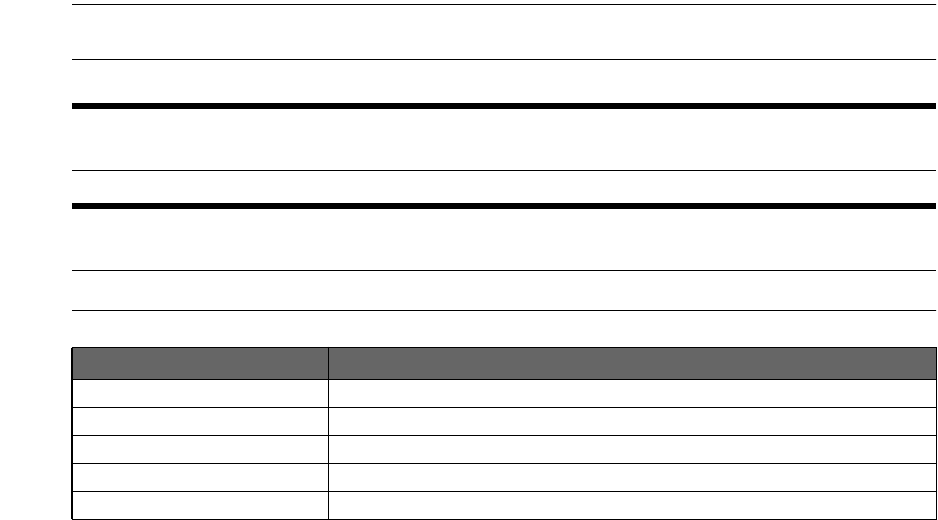
iv
About This Guide
The HomePortal® 4111N/4112N Intelligent Gateway Installation Guide is designed to serve as a reference for
installing the gateway. The guide contains the following sections:
Introducing the HomePortal Intelligent Gateway on page 1
Installing the HomePortal Intelligent Gateway on page 3
Troubleshooting Installation Issues on page 8
Regulatory Information on page 10
Audience
This guide is intended for use by:
• End Users
• Sales Engineers
• Support Staff
• ISP Technicians
Style Conventions
The following style conventions are used in this guide:
Note Notes contain incidental information about the subject. In this guide, they are used to provide
additional information about the product and to call attention to exceptions.
mCaution notes identify information that helps prevent damage to hardware or loss of data.
cWarning notes identify information that helps prevent injury or death.
Typographical Conventions
Convention Used For
Blue Text Cross references
Bold Interface elements that are clicked or selected, field inputs, and term lists
Italic Emphasis, book titles, variables
Monospace Command syntax and code
Monospace Italic Variables within command syntax and code

Related Documents v
HomePortal® 4111N/4112N Intelligent Gateway Installation Guide About This Guide
Related Documents
In addition to this guide, the HomePortal Intelligent Gateway documentation library includes:
Support
Technical support is available from the 2Wire Web site: http://support.2wire.com/index.php.
Agile Part Number Description
TBD HomePortal® 4111N/4112N Intelligent Gateway Hardware Specifications
TBD HomePortal® 4111N Intelligent Gateway Hardware Release Notes
1
CHAPTER 1
Introducing the HomePortal Intelligent
Gateway
Welcome to the Pace family. The gateway delivers a powerful user experience with its easy-to-use features. It
provides high-speed Internet access, integrated data applications, and support for wireless-wireline
convergence. The gateway also offers a host of other features such as:
•Flexible Networking Options
High-powered 802.11b/802.11g/802.11n wireless Access Point (AP) and Ethernet ports on the gateway
for optimized home networking.
•Superior Wireless Experience
Wireless technology implemented on the gateway virtually eliminates wireless “cold spots” in your
home.
•Super Fast Router
The gateway offers fast data transfer speeds between your home network and the Internet. The high-
performance router distributes data seamlessly to all of the computers on your home network, without
compromising performance or speed.
•Professional Grade Firewall
The gateway actively detects and defends against common Internet threats (such as Distributed Denial
of Service attacks) using Stateful Packet Inspection. Easy-to-use tools enable simple configuration for
common in-home applications such as online gaming.
•Broadband Interface Options
The gateway supports Broadband connectivity through the ADSL or the Ethernet port.
Components
You can configure your Broadband connection on your gateway through the DSL or Ethernet port. Before
installing your gateway, review the package contents and ensure that you have the required items. The figures
below illustrate the installation of the gateway through the DSL and Ethernet Broadband ports.
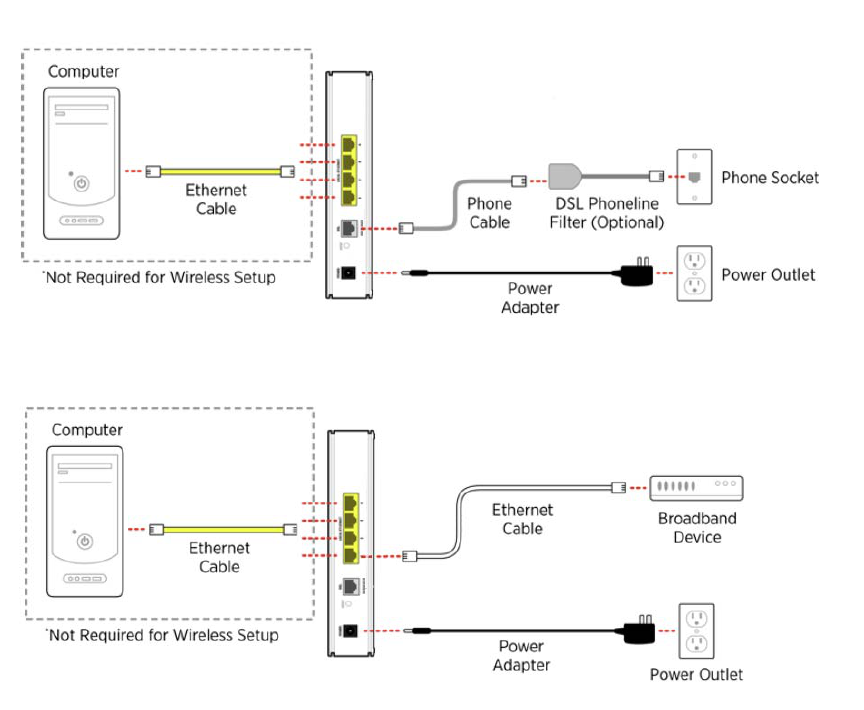
Components 2
HomePortal® 4111N/4112N Intelligent Gateway Installation Guide Introducing the HomePortal Intelligent Gateway
Figure 1: Setup for DSL Broadband Connection
Figure 2: Setup for Ethernet Broadband Connection
See Also
Installing the HomePortal Intelligent Gateway on page 3
Regulatory Information on page 10

Determining Gateway Location 3
HomePortal® 4111N/4112N Intelligent Gateway Installation Guide Installing the HomePortal Intelligent Gateway
CHAPTER 2
Installing the HomePortal Intelligent
Gateway
The installation of your gateway consists of the following tasks:
Connecting the Power Adapter on page 3
Connecting Your Computer to the Gateway on page 4
Connecting the Broadband Interface through DSL port on page 6
Connecting the Broadband Interface through the Ethernet Port on page 6
Connecting the IPTV Set-top Box on page 7
Determining Gateway Location
Before installing the gateway, you must determine an appropriate location. The gateway must be installed near
the main computer to connect through any of the Local Ethernet ports. Wireless signals are affected by many
items in homes and offices. Reliability and performance are the major considerations when planning your
wireless network location.
Consider the following suggestions when determining the wireless AP location:
• Place your gateway at least 5 feet (1.52 meters) from cordless phones, microwave ovens, or other
electronic devices to avoid potential interference, and more than 6 inches (15.24 centimeters) away
from your television to avoid audio hissing or static.
• Place the gateway in an open area where the wireless range will be susceptible to the least possible
interference from its surroundings. Wireless signal strength will be much stronger in an open area than
an area with obstructions. In a single-story building, place the gateway as high and as close to each
wireless computer as possible.
• Keep the gateway away from large metal objects. Wireless signal quality deteriorates if metal objects
reflect or obstruct signals.
• Keep the gateway away from water sources like water coolers and fish tanks.
Note It is recommended that the stand provided with the gateway be used to install the gateway in a vertical
position, such that nothing can be stacked on top of it.
Connecting the Power Adapter
To power on the gateway:
1. Connect one end of the power adapter to the POWER port of your gateway.
2. Connect the cable’s other end to an electrical outlet.
Once the gateway is powered on, the power LED blinks green for a brief period of time and then turns steady
green.
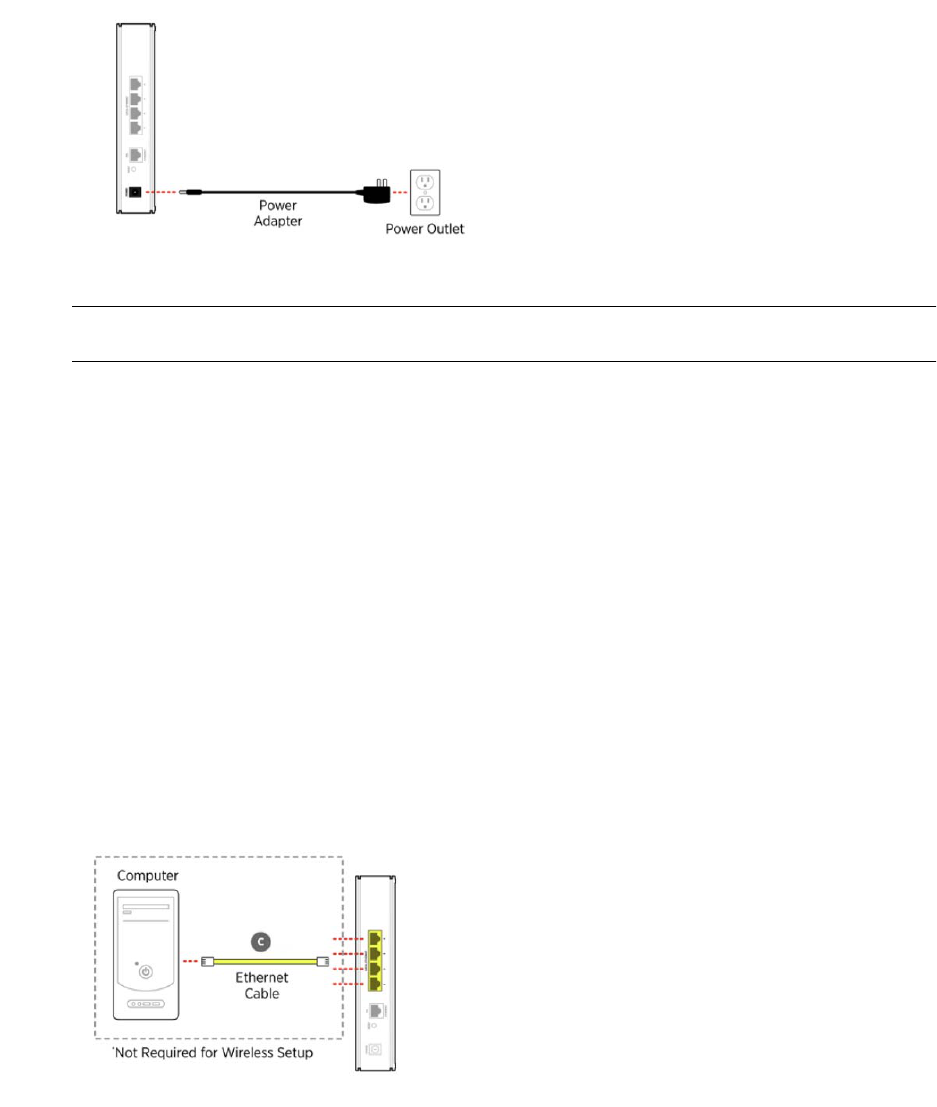
Connecting Your Computer to the Gateway 4
HomePortal® 4111N/4112N Intelligent Gateway Installation Guide Installing the HomePortal Intelligent Gateway
Figure 3: Power Connection
Note Always use the Pace power adapter packaged with the gateway, as it is compliant with the local
regulatory requirements.
Connecting Your Computer to the Gateway
The first computer you connect to the gateway is used to configure the gateway for proper operation. You can
connect your gateway to additional computers and/or other devices via Ethernet cable and wireless AP.
Connecting through Local Ethernet
The gateway has four Ethernet ports for connecting computers or devices to the gateway. Use the Ethernet
interface(s) on the gateway to create a home network.
To connect the computer and the gateway using the Ethernet cable:
1. Connect one end of the Ethernet cable (yellow-colored) to any available LOCAL ETHERNET port on the
gateway.
2. Connect the cable’s other end to the Ethernet port of the Network Interface Card (NIC) on the
computer.
After the gateway recognizes the computer, the relevant Ethernet LED turns steady green, and then starts
flickering once the computer starts data transfer with the gateway.
Figure 4: LAN Connection
Connecting through Wireless
The gateway has an integrated wireless AP that enables you to connect your wireless-enabled computers to your
gateway. By default, the gateway is shipped with pre-enabled WPA-PSK/WPA2-PSK and a pre-configured
network name.
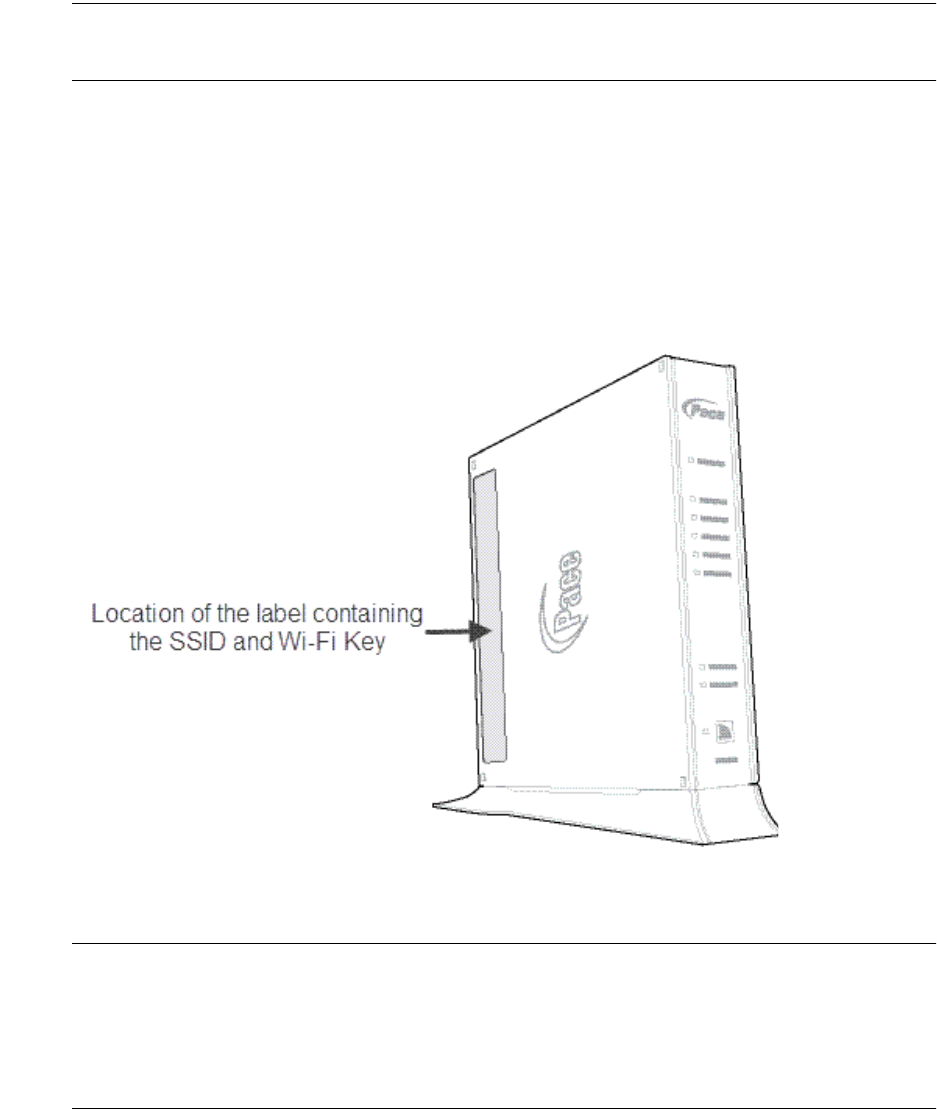
Connecting Your Computer to the Gateway 5
HomePortal® 4111N/4112N Intelligent Gateway Installation Guide Installing the HomePortal Intelligent Gateway
Most laptops are equipped with an internal 802.11b/g card. If your computer is not equipped with an internal
card, you can install an external wireless adapter for wireless networking.
Note The default network name (SSID) and the encryption key (64-bit hex value) is located at the bottom
label on the side of the Pace gateway (for example, 1234567891). Mac OS X users may have to enter the
“$” character at the beginning of the encryption key (for example, $1234567891).
To connect the computer and the gateway using wireless AP:
1. Install and configure your wireless adapter, if required.
2. View the available wireless network connections. Use the network adapter client or Windows Wireless
Network Connection wizard to view the wireless connections.
3. Select the network name of the gateway from the menu, and click Connect. A prompt to enter the
network key appears.
4. Enter the encryption key and click Connect. Refer the note above for the location of the key.
Once the gateway recognizes the wireless client, the WIRELESS LED turns steady green, and then starts
flickering once the wireless client starts the data transfer with the gateway.
Figure 5: Wireless Network Key Location
Note You can configure Wi-Fi Protected Setup (WPS) for simplifying the process of connecting any home
device to the wireless network using the PIN or PUSH method. PIN method establishes wireless
connectivity using the PIN generated by the wireless client. Use this method to enter the PIN generated
by the wireless client in the Device PIN text box on the user interface of the gateway and click Connect.
The PUSH method establishes the wireless connectivity if you push the WPS button found at the front
panel of the gateway followed by using the PUSH method on the client device (as advised by the
manufacturer of the wireless client).
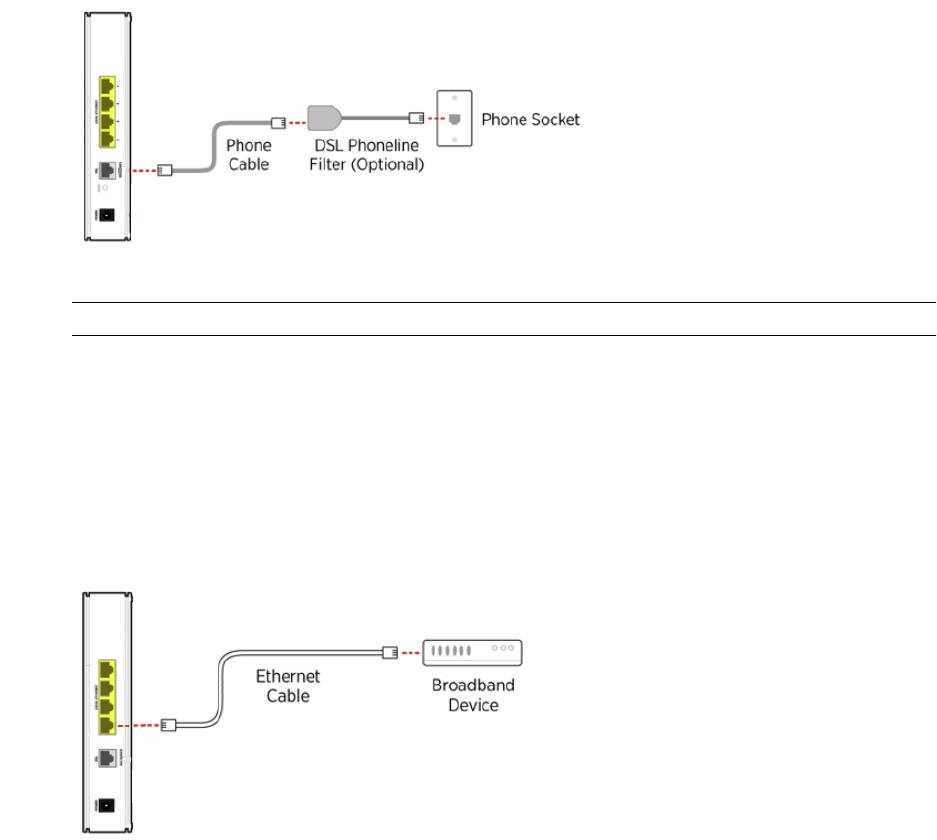
Connecting the Broadband Interface through DSL port 6
HomePortal® 4111N/4112N Intelligent Gateway Installation Guide Installing the HomePortal Intelligent Gateway
Connecting the Broadband Interface through DSL port
To connect the gateway to an Asymmetric Digital Subscriber Line (ADSL) wall jack:
1. Connect one end of the phone cord/twisted pair cable to the DSL port (green-colored) on your
gateway.
2. Connect the cable’s other end to the DSL port of the filter, which must be plugged into the ADSL-
enabled wall jack outlet.
Once the gateway recognizes the ADSL connection, the Broadband LED blinks green for a brief period of time,
and then turns steady green.
Figure 6: ADSL Broadband Connection
Note The gateway must be connected through the DSL phoneline filter.
Connecting the Broadband Interface through the Ethernet Port
To connect the gateway to a RJ-45 jack of the fiber optic device:
1. Connect one end of the Ethernet cable to the Ethernet port (yellow-colored) on your gateway.
2. Connect the cable’s other end to the Broadband device.
Once the gateway recognizes the Ethernet connection, the Broadband LED blinks green for a few seconds, and
then turns steady green.
Figure 7: Ethernet Broadband Connection
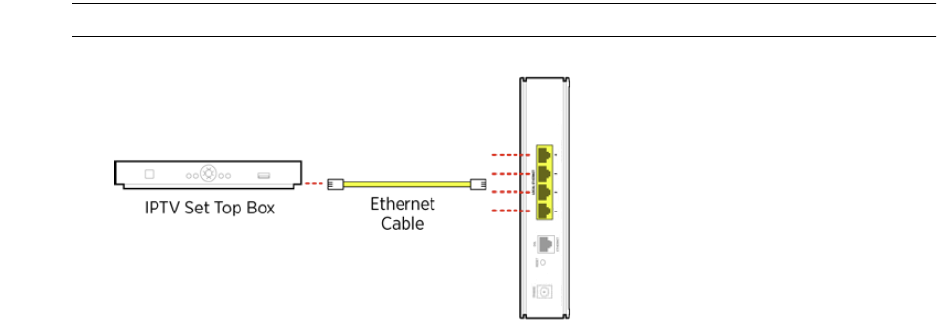
Connecting the IPTV Set-top Box 7
HomePortal® 4111N/4112N Intelligent Gateway Installation Guide Installing the HomePortal Intelligent Gateway
Connecting the IPTV Set-top Box
The gateway can be configured to use IPTV services through the Local Ethernet port.
To connect the gateway and the set-top box:
1. Connect one end of the Ethernet cable to the Local Ethernet port of the gateway.
2. Connect the cable’s other end to the Ethernet port of the set-top box.
As soon as the gateway recognizes the set-top box, the relevant Ethernet LED turns steady green, and then
starts flickering once the set-top box starts data transfer with the gateway.
Note Refer to the set-top box manufacturer’s instructions for further information.
Figure 8: IPTV Connection Over Local Ethernet
See Also
Troubleshooting Installation Issues on page 8

8
CHAPTER 3
Troubleshooting Installation Issues
This chapter provides information about troubleshooting gateway installation issues. It lists the issues, possible
cause and solution for the issues. The issues mentioned in this chapter are based on likely user scenarios.
Connection Issues
The following table provides information to troubleshoot connection issues:
Issue Possible Cause What to Do
No POWER light Power supply is faulty • Verify that the LED on the AC power cable is steady
green.
• Verify that the AC power cable is securely connected to
the gateway.
• Ensure that the AC power cable is not plugged into a
switched outlet that is powered off.
• Power up the gateway with a known good power outlet.
• Replace the location of the gateway if it does not power
up with a known good power outlet.
• If the issue persists, replace the AC power cable.
POWER LED blinks just after
starting the device and then
turns steady green
Power on self-test (POST) Normal behavior.
POWER LED is steady red System POST Failure • Press the Reset button on the gateway for 10 seconds.
• Replace the gateway if it does not power up into a normal
state.
BROADBAND LED blinking ADSL connection not
established
Verify if ADSL service is activated on the phone cable
connected to the gateway. To do so, contact the ISP.
Loose Ethernet or DSL cable Check the Ethernet cable connection on the gateway and
the phone jack, and make sure it is securely seated in both
ports.
SERVICE LED blinking Internet service not activated Contact your ISP to activate Internet service.
BROADBAND LED blinks green
for an extended period of time,
then turns steady red
Failed broadband link
synchronization between the
gateway and the DSLAM with
which it is directly connected
• Check the Ethernet cable connection on the computer
and gateway, and make sure it is securely seated in both
port.
• Verify if ADSL service is activated on the phone cable
connected to the gateway. To do so, contact the ISP.
SERVICE LED is steady red Internet service authentication
failure and/or failure to receive
address assignment
• Contact your ISP to check if the Internet connection is
activated.
• Check if the PPPoE or DHCP server is assigning an IP
address to your gateway.
• Check if you have entered a valid User name and
Password to connect to the Internet.
No ETHERNET light Inadequate connectivity Check the Ethernet cable connection on the computer
and gateway, and make sure it is securely seated in both
the ports.
No WIRELESS light LAN clients are not connected
to the gateway through the
wireless interface
Ensure that at least one LAN client is connected to the
wireless connection of the gateway.
Internet is not accessible, but
user interface of the gateway is
accessible
Inadequate connectivity Check the physical connection of the RJ-11 cable to the
phone line port of the gateway device. Try using a
different cable.
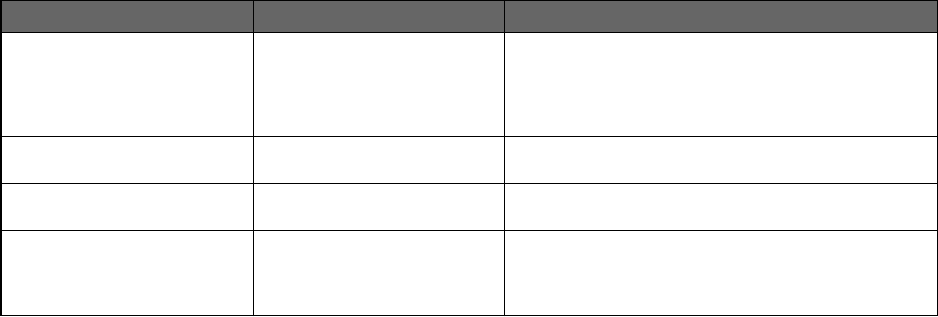
LAN Issues 9
HomePortal® 4111N/4112N Intelligent Gateway Installation Guide Troubleshooting Installation Issues
LAN Issues
The following table provides information to troubleshoot LAN issues:
Issue Possible Cause What to Do
Unable to connect to the
gateway through the local
Ethernet port
Loose Ethernet cable
connection
• Check the Ethernet cable connection on the computer
and gateway, and make sure it is securely seated in both
ports.
• Check the ETHERNET indicator on the gateway. The
associated Ethernet port LED flickers green.
Wireless client is not getting an
IP address
Wireless modes on client and
AP are not compatible
Ensure that the wireless mode on the wireless client is
compatible to the wireless mode on the gateway.
Wireless signal strength is
weak
Wireless client is not in the
wireless range
Ensure that your wireless client is within the wireless
range of the gateway.
Setting custom encryption key
on the user interface gives an
error
Custom encryption key is not
conforming with the security
mode, key length, key type, or
value type
Configure the custom encryption key in a way that it
conforms to the security mode, key length, key type, or
value type.

10
APPENDIX A
Regulatory Information
Electrical
AC Adapter
This product is intended to be supplied by a listed 2Wire Direct Plug-In AC/DC Power adapter marked Class 2 or
LPS and rated 14.5VDC, 0.8A for all 41xxN-xxx models.
The AC adapter is designed to ensure your personal safety and to be compatible with this equipment. Please
follow these guidelines:
• Do not use the adapter in a high-moisture environment. Never touch the adapter when your hands or
feet are wet.
• Allow adequate ventilation around the adapter. Avoid locations with restricted airflow.
• Connect the adapter to a proper power source. The voltage and grounding requirements are found on
the product case and/or packaging.
• Do not use the adapter if the cord becomes damaged.
• Do not attempt to service the adapter. There are no serviceable parts inside. Replace the unit if it is
damaged or exposed to excess moisture.
Telecommunication Cord
Location – Electrical Considerations
Equipment
Repairs
Do not, under any circumstances, attempt any service, adjustments, or repairs on this equipment. Instead,
contact your local 2Wire distributor or service provider for assistance. Failure to comply may void the product
warranty.
mTo reduce the risk of fire, use only No. 26 AWG or larger UL Listed or CSA Certified
Telecommunication Line Cord.
mTo reduce the risk of electrical shock or damage, do not use this product near water, including a
bathtub, wash bowl, kitchen sink or laundry tub, in a wet basement, or near a swimming pool. Also,
avoid using this product during electrical storms. Avoid locations near electrical appliances or other
devices that cause excessive voltage fluctuations or emit electrical noise (for example, air
conditioners, neon signs, high-frequency or magnetic security devices, or electric motors).

Declaration of Conformity 11
HomePortal® 4111N/4112N Intelligent Gateway Installation Guide Regulatory Information
Location – Environmental Considerations
Do not plug the AC/DC power adapter in an outdoor outlet or operate the gateway outdoors. It is not waterproof
or dustproof, and is for indoor use only. Any damage to the unit from exposure to rain or dust may void your
warranty.
Do not expose the residential gateway to high heat, dust, humidity, moisture, caustic chemicals, or oils. Keep the
gateway away from direct sunlight and any material that radiates heat, such as a stove or a motor.
Declaration of Conformity
FCC / Industry Canada Compliance
This device has been tested and certified as compliant with the regulations and guidelines set forth in the
Federal Communication commission - FCC part 15, FCC part 68 and Industry Canada - ICES003 and RSS-210
Radio and telecommunication regulatory requirements.
Le présent materiel est conforme aux specifications techniques applicables d’Industrie Canada. Cet appareil
numérique de la classe [*] est conforme à la norme NMB-003 du Canada.
Manufacturer: 2Wire, Inc. DBA Pace Americas
Model(s): 4111N, 4112N
Part 15 of FCC Rules
This device complies with Part 15 of the FCC Rules. The operation of this device is subject to the following two
conditions:
1. This device may not cause harmful interference.
2. This device must accept any interference received, including interference that may cause undesired
operation.
This equipment has been tested and found to comply with the limits for a Class B digital device, pursuant to part
15 of the FCC Rules. These limits are designed to provide reasonable protection against harmful interference in a
residential installation. This equipment generates, uses and can radiate radio frequency energy and, if not
installed and used in accordance with the instructions, may cause harmful interference to radio communications.
However, there is no guarantee that interference will not occur in a particular installation. If this equipment does
cause harmful interference to radio or television reception, which can be determined by turning the equipment
off and on, the user is encouraged to try to correct the interference by one or more of the following measures:
• Reorient or relocate the receiving antenna
• Increase the separation between the equipment and receiver
• Connect the equipment into an outlet on a circuit different from that to which the receiver is connected
• Consult the dealer or an experienced radio/TV technician for help
TIA 968 (Part 68 of FCC Rules) / IC CS-03
This equipment complies with the Telecommunication Industry Association TIA-968 (FCC part 68) and Industry
Canada CS-03 Telecommunication requirements. On the product is a label that contains, among other
information, the IC and FCC registration number and ringer equivalence number (REN) for this equipment. If
requested, this information may be provided to the telephone company.
mChanges or modifications not expressly approved by the party responsible for compliance could void
your authority to operate this equipment.

Declaration of Conformity 12
HomePortal® 4111N/4112N Intelligent Gateway Installation Guide Regulatory Information
The REN is used to determine the quantity of devices that may be connected to the telephone line. Excessive
RENs on the telephone line may result in the device not ringing in response to an incoming call. In most, but not
all areas, the sum of the RENs should not exceed five (5.0).
L’indice d’équivalence de la sonnerie (IES) sert à indiquer le nombre maximal de terminaux qui peuvent être
raccordés à une interface téléphonique. La terminaison d’une interface peut consister en une combinaison
quelconque de dispositifs, à la seule condition que la somme d’indices d’équivalence de la sonnerie de tous les
dispositifs n’excède pas 5.
To be certain of the number of devices that may be connected to the line, as determined by the total RENs,
contact the telephone company to determine the maximum RENs for the calling area.
This product cannot be used on telephone-company-provided coin service. Connection to Party Line Service is
subject to state tariffs.
An FCC-compliant telephone cord and modular plug is provided with this equipment. This equipment is
designed to be connected to the telephone network or premises wiring using a compatible modular jack that is
Part 68 compliant. If this equipment causes harm to the telephone network, the telephone company will notify
you in advance that temporary discontinuance of service may be required. If advance notice is not practical, the
telephone company will notify the customer as soon as possible. Also, you will be advised of your right to file a
complaint with the FCC if you believe it is necessary. The telephone company may make changes in its facilities,
equipment, operations, or procedures that could affect the operation of this equipment. If this happens, the
telephone company will provide advance notice in order for you to make the necessary modifications to
maintain uninterrupted service. If trouble is experienced with this equipment, please contact 2Wire, or your local
2Wire distributor or service center in the U.S.A. for repair and/or warrant information. If the trouble is causing
harm to the telephone network, the telephone company may request you to remove this equipment from the
network until the problem is resolved. No repairs can be done by a customer on this equipment. It is
recommended that the customer install an AC surge arrestor in the AC outlet to which this device is connected.
This is to avoid damage to the equipment caused by local lightning strikes and other electrical surges.
MPE/SAR/RF Exposure Information
This device was verified for RF exposure and found to comply with Council Recommendation 1999/519/EC and
FCC OET-65 RF exposure requirements. This equipment complies with FCC radiation exposure limits set forth for
an uncontrolled environment.
cWhile this device is in operation, a separation distance of at least 20 cm (8 inches) must be
maintained between the radiating antenna inside the EUT and the bodies of all persons exposed to
the transmitter in order to meet the FCC RF exposure guidelines. Making changes to the antenna or
the device is not permitted. Doing so may result in the installed system exceeding RF exposure
requirements. This device must not be co-located or operated in conjunction with any other antenna
or radio transmitter.